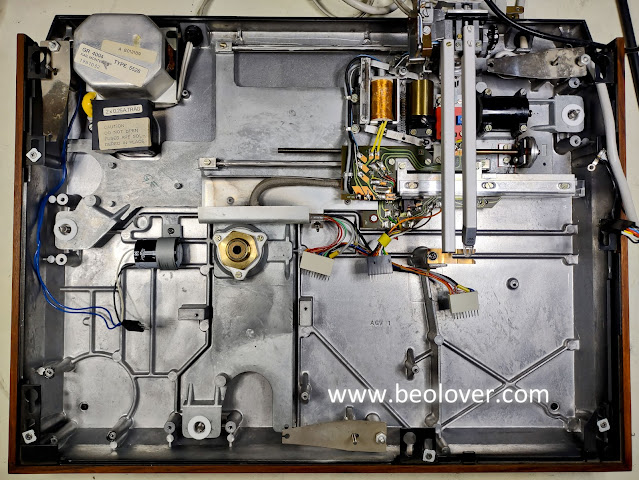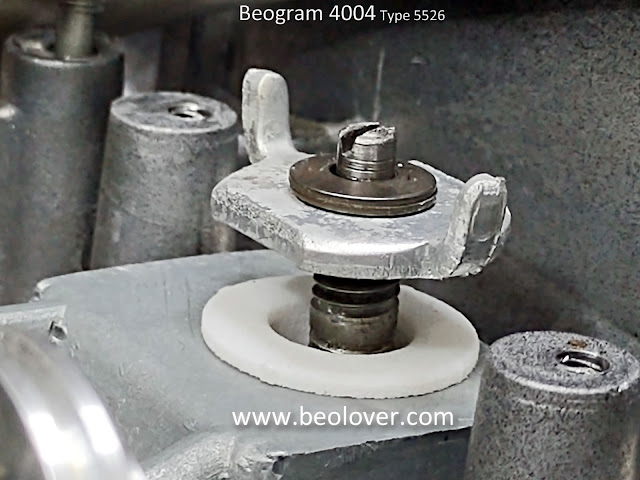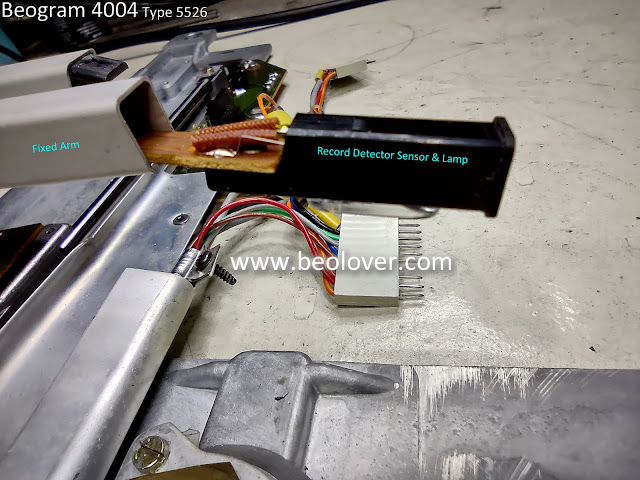From the checks I made in the previous post I knew there were adjustments that needed to be made on this project. That is expected when new parts are installed.
I had also noticed that while the Beogram 4004 arm solenoid was engaging to cue the tonearm down, it was not cueing back up correctly. There was a delay from when the raise tonearm signal occurs and when the solenoid disengages. We have seen that problem before and it was with the solenoid plunger sticking.
First though...I wanted to adjust the steady state voltage of a couple of the Beogram 4004 sensors.
The adjustment trimmers are both on PCB 1.
One is the position sensor (4IC1) steady state voltage level. I adjusted the 4IC1 collector to 5 VDC using PCB 1 trimmer 1R88.
Note: The 5 VDC voltage adjustment for the 4IC1 collector is made when the tangential arm is at a point in its travel where the position sensor lamp is shining through a clear section of the position scale.
After that adjustment I wanted to get the detector arm sensor adjusted using the new 1R26 trimmer...so I could move the trimmer to its final position on the component side of PCB 1.
I had to change my 1R26 trimmer during this adjustment because my initial 2MΩ trimmer did not have enough range. The 1R26 trimmer shown below is a 5MΩ trimmer and it allowed me to set the voltage at the 1TR3 collector to 4 VDC (the desired steady state voltage level).
I de-soldered 1R26 from the component side of PCB 1 and moved it to the component side.
This is the motor that Beolover restored back in January.
Here is a sequence of photos that show installing the platter motor, sub-platter, belt and top platter.
Things look great with the silent running platter motor that Beolover restored.
Normally I would move right into more service manual adjustments but I need to take care of the arm lowering, solenoid problem.
I removed the solenoid assembly so I could take it apart.
With the solenoid assembly removed I ran a check of the coil (it measured good... 9.3Ω) and energized the solenoid (using my 30V bench power supply).
When installed in the Beogram 4004 the Beogram controller applies a voltage of around 30 VDC to the solenoid to engage it. The duration of that signal is less than 40 milliseconds then it drops down to around 1.8 VDC to hold the solenoid engaged.
When removed from the Beogram 4004 the solenoid engaged at a much less voltage (around 5 VDC and a current of 0.49 Amps).
The problem with this solenoid wasn't engaging though.
The problem was with disengaging. The plunger was sticking.
When the arm lowering solenoid was disengaged I could feel resistance when manually trying to move the solenoid plunger to the raised tonearm position.
Here are the Beogram 4004 solenoid assembly components.
I cleaned all of the moving parts with acetone and I applied new tape to the coil as the original tape was coming off.
When a solenoid plunger is sticking it is tempting to apply lubricant to the moving parts.
Don't do that. Oil and grease will make the problem worse and interfere with proper plunger movement inside the guide assembly.
The parts need to be smooth and clean which is why I used acetone to clean them (including the inside of the guide tube).
The solenoid sticking problem is similar to a Beogram 800x tonearm lowering mechanism sticking.
With a Beogram 800x there is a metal screw (used to adjust the parallelism between the tonearm and fixed arm) that sticks to a metal plate when in contact. The solution there is to apply a thin layer of plastic between the two metal pieces so they don't make physical contact.
The same is true here. The end of the plunger with the threaded hole for the control rod travels to the end of the guide assembly tube where it makes contact with the metal end stop.
After a period of time the two pieces of metal that make contact start sticking together. Initially I thought it was a magnetic build up and I tried using a demagnetizer to solve the problem. It appeared to do the trick but now I think it was due more to my cleaning of the solenoid components.
This time I cut and applied a thin piece of yellow tape (like that used to wrap the coils) to the end of the plunger. That prevents metal on metal contact when the plunger is all the way forward (arm lowered).
I could already see a huge improvement.
Prior to applying the tape I could manually move the plunger all the way forward but had resistance trying to move the plunger back.
Even when I turned the solenoid on end, the plunger would not fall out of the guide.
It just stuck to the end of the guide.
Now, since the metal ends are not making direct contact, the plunger easily slides back out.
Note: The thickness of the material is important. In the past I tried using a thin, nylon washer on the plunger end as a barrier. The material wasn't thin enough and prevented the solenoid from lowering properly.
The proof is in actually testing the arm lowering and raising so I re-installed the solenoid and gave it a test.
It works perfectly now. The arm raising is immediate. No delay.
Note: In the above photos of the solenoid lowered/raised I hadn't re-installed the holding clip on the lowering lever pivot post. That has been installed now. In case anyone was worrying I missed that :-).
Now I can get back to the service manual adjustments.





















































